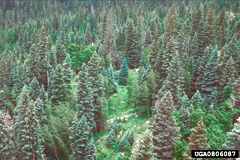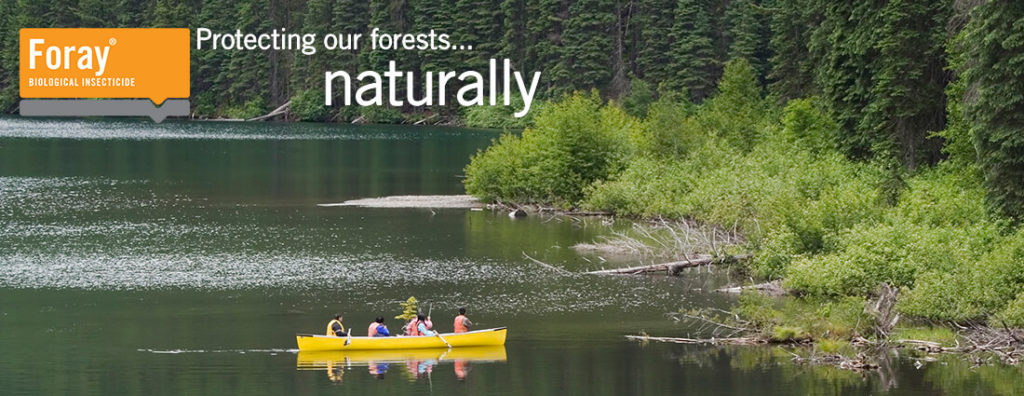Insect Growth Regulator (Mimic 2LV, Mimic 240LV)
Mimic® 2LV (labeled as Mimic® 240LV in Canada) is an effective insecticide, an insect growth regulator (IGR) that was developed to control specific caterpillar pests that defoliate trees and forests. The active ingredient of Mimic 2LV/ Mimic 240 LV tebufenozide, is fully also registered and used in many countries for protection of both agricultural crops and forests from caterpillar (Lepidoptera) pests.
Mimic is an insect growth regulator that has a unique mode of action. Mimic induces a premature molt in susceptible caterpillar species, ultimately causing death of the caterpillar. When treated foliage is consumed by the caterpillar, the active ingredient, tebufenozide, ‘mimics’ the natural hormone (ecdysone) produced by caterpillar pests to induce a molt. Each molting stage results in a larger more developed ‘instar’. The caterpillar must molt (shed its outer cuticle or ‘skin’) because its cuticle will not expand as the larvae feeds and grows in size. Mimic initiates and then accelerates this molting process and produces a new, malformed cuticle under the existing cuticle and prevents the insect from shedding its old cuticle. This puts pressure on the larvae, preventing it from feeding and growing. This happens within a day; death follows shortly thereafter.
The objective of applying Mimic to the forest is to stop destructive caterpillar larvae from consuming tree foliage and causing weakened trees and forests. The larvae stop feeding within 24 hours of exposure to Mimic 2LV and soon thereafter, affected larvae undergo an unsuccessful (and lethal) molt.

Some contact activity has also been observed in some species of caterpillars, however the primary method of exposure is through the ingestion of foliage that has been treated with Mimic. Once a toxic dose of Mimic has been consumed, caterpillar larvae quickly cease feeding. It may take 2 to 4 days for the affected larvae to die, however, there is no further feeding by the affected larvae during this time. As such, Mimic achieves high rates of mortality and foliage preservation.
Mimic is a unique compound and it has an extremely target-specific mode of action: only the ecdysone receptors of Lepidoptera insects are targeted and only when they are in the larval (caterpillar) stage. When used as directed, Mimic poses no significant impact to the environment or to non-lepidopteran insect species. There have been over a million acres of forested lands protected from defoliating caterpillar pests since Mimic was first introduced.
Mimic is ideally suited for Integrated Pest Management programs which depend upon natural predators or beneficial insects to help foster the decline of the target pest. Mimic 2LV has no direct impact upon beneficial insects, parasites or predators. Unlike other insect growth regulators used to control caterpillar pests in the forest, Mimic 2LV is specific to lepidopteran (caterpillar) pests and has no impact upon aquatic invertebrates such as crayfish, shrimp etc. Mimic also has no effect upon pollinators, grasshoppers, crickets, beetles, weevils, or flies.
Compared to other forestry insecticides, Mimic offers a large window of application due to a longer half-life; this can be especially helpful in controlling later hatched caterpillars without need of a second application. The half-life of Mimic 2LV ranges from 18 to 44 days in deciduous foliage and coniferous needles, depending upon application rates and exposure of the spray deposit to sunlight and microbial activity.

Like all forestry insecticides, Mimic should not be applied directly to open waterbodies but there are no buffer zones associated with Mimic. It is not very soluble in water and degrades over time due to the effects of sunlight, weathering, and microbial activity and because it is not very water soluble, tebufenozide becomes quickly bound up in the plant tissue, or in the duff and debris on the forest floor.
Suggested Rate Range for Control of Forest Pests (U.S. label rates are used as an example) US and Canadian labels are included below (see Downloads)
| TARGET PESTS | APPLICATION (fl. oz./acre) | APPLICATION TIMING |
Bagworm (Thyridopteryx ephemeraeformis) Browntail Moth (Euproctis chrysorrhoea) Elm Spanworm (Ennomos subsignaria) Fall Cankerworm (Alsophila pometaria) Fall Webworm (Hyphantria cunea) Spongy Moth (Lymantria dispar) Hemlock Looper (Lambdina fiscellaria) Jack Pine Budworm (Choristoneura pinus) Puss Caterpillar (Megalopyqe opercularis) Tent Caterpillars: Forest, Eastern, Western (Malacosoma disstria, M. americanum, M. californicum) Zimmerman Pine Moth (Dioryctria zimmermani) | 4.0 to 8.0 (0.06 to 0.12 lb). a.i./acre | Apply to early instar (1st, 2nd, or 3rd) larvae. In general, foliage development should be a minimum of 20%. |
| Spruce Budworms (Choristoneura fumiferana, C. occidentalis) | 4.0 to 8.0 (0.06 to 0.12 lb. a.i./acre) | Make applications to 4th – 5th instar larvae that are actively feeding on foliage or are feeding outside the candle caps. |
| Tussock Moths (Dasychira pinicola, Lophocampa maculata, Orgyia pseudotsugata, O. vetusta) | 4.0 to 8.0 (0.06 to 0.12 lb. a.i./acre) | Apply at full hatch and well into early dispersal, (75% off egg mass) or to 4th – 5thinstar larvae that are actively feeding on foliage or are feeding outside the candle caps. |
| Pine Tip Moths (Rhyacionia frustrana, R. neomexicana, R. buoliana, R. rigidana, R. subtropica) | 8.0 (0.12 lb. a.i./acre) | Apply to early instar (1st – 2nd) larvae after each new foliage flush, in general, at approximately 25% shoot expansion. |
Note: Not registered for use on forests in California or New York
Restrictions: Do not apply more than 16 fluid ounces per acre per year.
Uniform coverage of the foliage is essential to provide maximum protection from defoliation and a significant reduction of caterpillar larvae.
Resources
Learn more about Mimic®

